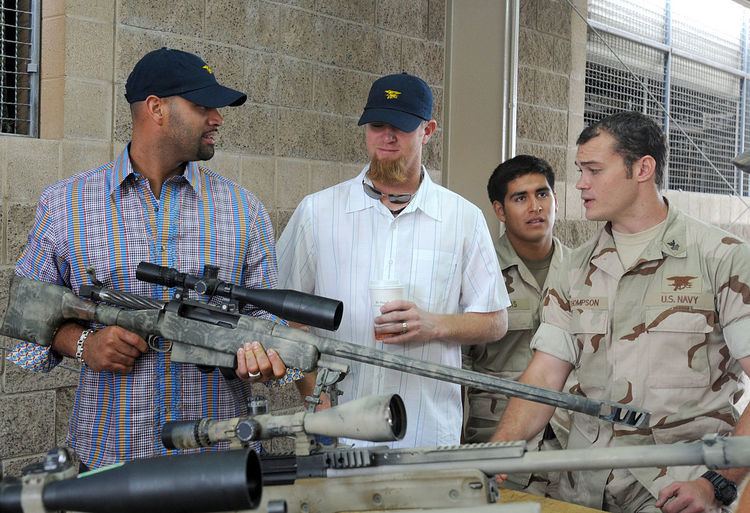Place of origin United States Used by See Users Designed 1980s | In service 2000-present Wars Afghanistan War | |
 | ||
Type Anti-materiel rifle, sniper rifle | ||
The McMillan Tac-50 sniper rifle is produced in Phoenix, Arizona in the United States by McMillan Firearms Manufacturing. This long-range anti-material/anti-personnel weapon is based on previous designs from the same company, which first appeared during the late 1980s. McMillan makes several versions of .50 caliber rifles, based on the same proprietary action, for military, law enforcement and civilian use.
Contents
The Tac-50 is a military and law enforcement weapon, which, designated as the C15, is the standard Long Range Sniper Weapon (LRSW) of the Canadian Forces since 2000. Rifles of the Tac-50 family are capable of outstanding accuracy and guaranteed to provide 0.5 MOA groups with match grade ammunition.
Design details
The McMillan Tac-50 is a manually operated, rotary bolt-action rifle. The large bolt has dual front locking lugs, and its body has spiral flutes to reduce weight. The heavy match-grade barrel, made by Lilja barrels, is also fluted to dissipate heat quickly and reduce overall weight and fitted with an effective muzzle brake to reduce recoil. The rifle is fed from detachable box magazines, holding 5 rounds each. The stock is made from fiberglass by McMillan Stocks, and is designed to be used from a bipod only. The buttstock is adjustable for length of pull with rubber spacers, and can be removed for compact storage. The rifle has no open sights and can be used with a variety of telescopic or night sights.
In Canadian service, the standard telescopic sight was the McMillan endorsed Leupold Mark 4-16x40mm LR/T M1 Riflescope optical sight that has now been replaced by the Schmidt & Bender 5-25x56 PMII telescopic sight. McMillan also endorses the Nightforce NXS 8–32x56 Mil-dot telescopic sight for the Tac-50.
Tac-50 A1
In 2012 the Tac-50 A1 variant was introduced. The TAC-50 A1 features a new take-down fiberglass stock with a forend that is 5 in (127 mm) longer compared to the Tac-50 stock. This moves the balance point for the bipod forward. The stock includes an integral cheekpiece and a monopod on the buttstock with an option for vertical adjustment. The stock incorporates a smaller pistol grip to fit a wider range of hand shapes, with and without gloves. The magazine release lever was repositioned ahead of the trigger bow to make the system easier to operate with gloved hands. For the A1 variant a new lighter bipod with legs that adjust vertically, as well as forward and rearward to fine-tune the rifle for elevation was also developed.
Tac-50 A1-R2
The Tac-50 A1-R2 variant was introduced in 2012 alongside the Tac-50 A1 variant. The A1-R2 variant is basically a Tac-50 A1 rifle system with a hydraulic recoil mitigation system (a proprietary hydraulic piston in the buttstock) added to reduce the considerable amount of free recoil the .50 BMG chambering generates and hence increase user comfort.
Deployment
Two Canadian snipers of the same Princess Patricia's Canadian Light Infantry (PPCLI) regiment sniper team made at the time the longest recorded sniper kills in history with this weapon in Afghanistan, during Operation Anaconda, in the Shah-i-Kot Valley. On a March afternoon in 2002, Master Corporal Arron Perry killed an enemy combatant from 2,310 meters (2,526 yd/1.435 miles) and Corporal Rob Furlong killed an enemy combatant from 2,430 meters (2,657 yd/1.509 miles) with 750 grain Hornady A-MAX very-low-drag bullets. These were the longest recorded kills by snipers in combat, surpassing the mark of 2,286 meters (2,500 yd/1.420 miles) set by U.S. Marine Gunnery Sergeant Carlos Hathcock during the Vietnam War. The five-man Canadian sniper team — MCpl Graham Ragsdale (Team Commander), MCpl Tim McMeekin, MCpl Arron Perry, Cpl Dennis Eason, and Cpl Rob Furlong — killed over 20 enemy combatants, and each of the five was nominated for the United States Armed Forces Bronze Star Medal.
These records were later broken in November 2009 by British Army Corporal of Horse Craig Harrison from the Household Cavalry. Harrison struck two Taliban machine gunners in a consecutive double kill south of Musa Qala in Helmand Province in Afghanistan, at a range of 2,475 m (2,707 yd/1.538 mi), using a .338 Lapua Magnum chambered British-made L115A3 Long Range Rifle.
